Getting Rid of Black Algae in Fish Tank
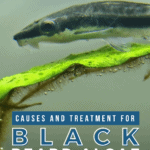
Many problem algae species grow in home fish tanks, clogging your filters, covering tank surfaces, obscuring the aquarium viewing panels, and generally spoiling the look of your setup. Black Beard algae, or Brush algae, are a particular nuisance, as they're incredibly difficult to shift once they've taken hold.
But don't despair! We've put together this comprehensive guide to show you how to get rid of Black Beard algae and prevent it from coming back.
What Is Black Beard Algae?
Black Beard algae are sometimes also called Brush algae and have the scientific name, Audouinella. The organism belongs to the larger family of red algae, which contains both marine and freshwater species. Black Beard algae primarily grow in tropical and temperate aquariums, although I have some growing in my coldwater goldfish tank where I've allowed it to grow and cover the back wall to obscure a tangle of cabling that runs behind the tank.
How Can You Identify Black Algae?
Black Beard algae can be black, gray, very dark green, and all shades in between. The organism first appears as tiny spots of raised stubble, typically along the edges of plants' leaves, before growing into fluffy tufts that resemble a brush or beard, hence the algae's common names. Given time to grow, the algae begins to resemble a flowing mane of hair or luxuriant hipster beard!
Brush algae quickly spread, covering your tank decorations, aquarium equipment, rocks, driftwood, your tank viewing panes, and even growing on individual grains of your gravel substrate.
Mistaken Identity?
Black Beard algae are sometimes confused with Staghorn algae. However, look closely, and you'll see that Staghorn algae have wiry, branching single, hair-like strands, whereas Brush algae have single, smooth strands that grow into a lush beard-like organism.
If you're still not sure what species of algae you have in your tank, immerse some of the algae in alcohol. If the algae turn a reddish color, that tells you that they are a species of red algae.
Do You Need To Remove Black Beard Algae?
Black Beard algae are not toxic. The main problem with the algae is that they can take over your tank, coating objects within the aquarium and covering the viewing panes.
However, if you control the spread of the algae and limit its growth to certain parts of the tank, you can incorporate the organism into your aquascaping. For example, a dense, flowing forest of dark green Black Beard algae growing over a piece of twisted root can create an interesting feature.
It's really just a matter of personal taste.
Is Black Beard Algae Harmful To Fish?
In short, no, colonies of Black Beard algae growing in your fish tank are not going to harm your fish or invertebrates. In fact, some small fish species seem to enjoy playing or hiding among the flowing manes of algae, and shrimp keep busy picking out fragments of food that have become caught in the beard.
That said, a blanket of black algae clinging to every single surface throughout your tank is very unsightly. Also, an overgrowth of algae can cause an imbalance in the levels of nutrients in the water, which could potentially make the environment unsafe for your fish. Once that happens, properly maintaining the tank will become more difficult and levels of toxic chemicals might rise, too.
Is Black Beard Algae Harmful To Plants?
Black Beard algae often first appear on your plants. This species of red algae latches onto the edges of the leaves of slow-growing plants, such as Anubias and Java fern, gradually spreading right across the whole plant, cutting out the light and blocking the plant's access to nutrition, eventually killing the algae's unfortunate host.
Algae use the same nutrients as plants, and if you have a serious overgrowth of Black Beard algae in your aquarium, your plants may struggle to get the nutrition they need. As a consequence, the plants will fail to thrive, or they might even die.
What Are The Common Causes Of Black Beard Algae?
Black Beard algae find their way unnoticed into your aquarium via various sources. Contaminated plants, transferred substrate from an infected tank, and items of décor are the most common items that can harbor tiny, invisible spores or colonies of algae, which don't become apparent until the organism starts to grow and spread.
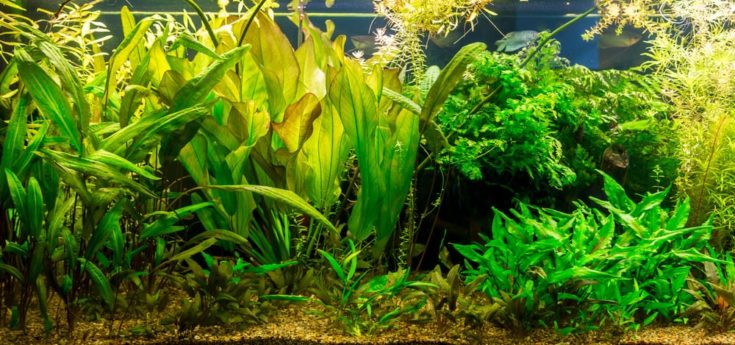
Once the aquarium has been infected, there are several factors that can create the perfect environment for the algae, encouraging it to spread and making the job of eradicating Brush algae extremely challenging. It's important to know that Brush algae spread much quicker in poorly maintained fish tanks than in aquariums that are regularly cleaned and properly cared for.
CO2 Levels And Black Beard Algae
Low or unstable levels of CO2 and inadequate water circulation in your tank will encourage Black Beard algae explosions. How so? Well, when the levels of CO2 are very low or fluctuate, the living plants in the aquarium are unable to utilize the nitrates and light that they need to photosynthesize. So, while that environment is a disaster for plants, it's a perfect storm for an explosion of Brush algae.
If you've carried out a very large water change, that can have a major impact on CO2 levels and could trigger an outbreak of Black Beard algae. If you use injected CO2, check that your canister is not running low, and double-check that the dosage you're using is correct. However, if you don't use CO2, you'll need to consider other methods of increasing the levels.
If you grow live plants in your tank, it's recommended that you add a high-quality liquid carbon to the water. That will only raise carbon levels slightly, but, more importantly, it's lethal to Black Beard algae. I recommend Seachem Flourish Excel liquid carbon, which is a tried and tested formula that's used by many experienced aquarists and aquascapers.
Light Levels And Beard Algae Growth Spikes
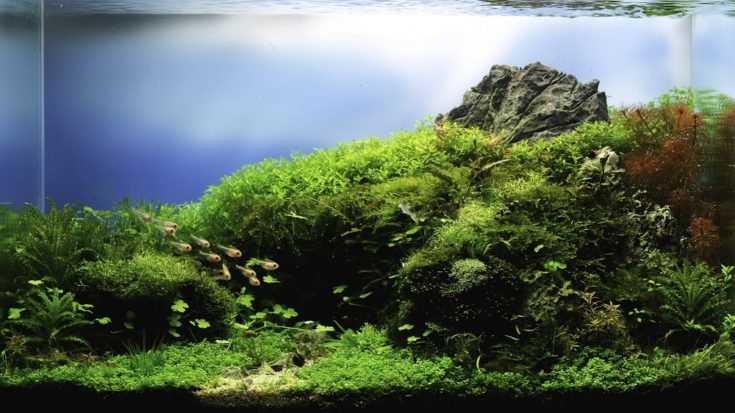
Just like your living plants, Black Beard algae thrive in an environment where there's plenty of light. Basically, the more light the algae receive, the more vigorously and quickly the colonies will spread. So, if you have your aquarium lights on for long periods, the algae will happily grow and proliferate right around your tank.
You can quickly and easily fix the problem by limiting the length of time you have your tank lights on. For convenience, I recommend that you switch to a lighting unit that has a built-in timer so that you don't have to turn the lights on and off manually. You shouldn't have your fish tank close to a window or in a place where the sun shines directly onto it, but if that's the case, either move the tank or shade it when the sun is out.
If you deprive the Black Beard algae of light, you'll discourage it from growing and potentially eliminate it altogether if you combine that strategy with other proven eradication methods.
How Do You Remove Blackbeard Algae?
It's not practical to remove the algae by hand; it's far too slimy!
However, there are several highly effective ways of eliminating Black Beard algae.
Hydrogen Peroxide (H2O2) Bath
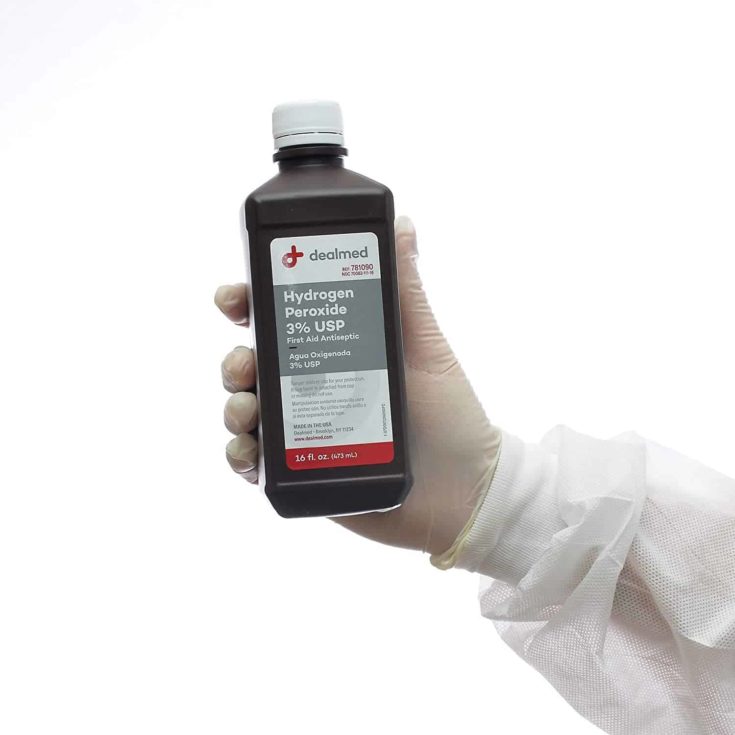
You can buy hydrogen peroxide over-the-counter in most drug stores, and this chemical makes a very handy addition to the hobbyist's stock of tank treatments. Note that you should only use the 3% H 2 O 2 product.
To kill Black Beard algae with hydrogen peroxide, you need to soak any affected plants, decorations, and aquarium equipment for around three minutes in undiluted 3% H2O2. After soaking, rinse everything thoroughly in freshwater.
Treat the Tank With H2O2
If it's not possible to remove individual items from your tank to treat them, and you can't tolerate the sight of any Black Beard algae in your aquarium, you'll need to treat the whole tank.
Use 10mls of undiluted 3% hydrogen peroxide per 15 gallons of tank water. For example, to treat a 30-gallon tank, you would need to use 20mls of undiluted 3% hydrogen peroxide. Add the hydrogen peroxide straight into the tank, close to the pump outlet, so that the chemical is evenly distributed right around your aquarium. Repeat the treatment once a day for three days.
Within a few days, the algae should begin to fade in color, and it should die off completely after a month or so. If the algae prove stubborn, you may need to repeat the process, using a slightly higher dosage rate.
During the treatment, your plants might fade slightly, but they will be fine. Your other livestock, including fish and invertebrates, should be unaffected. However, for your peace of mind, you might prefer to remove your pets from a quarantine tank for the duration of the algae treatment.
Regulate The Amount Of Phosphate (PO4) In Your Tank
Fish waste, dead plant leaves, uneaten fish food, and other miscellaneous organic waste in your tank can produce phosphates that encourage Brush algae to proliferate and spread. You can help prevent phosphate levels from increasing and starving the algae of nutrients by managing your tank correctly.
Every day, check your aquarium for dead plant material or deceased fish and invertebrates and immediately remove any casualties.
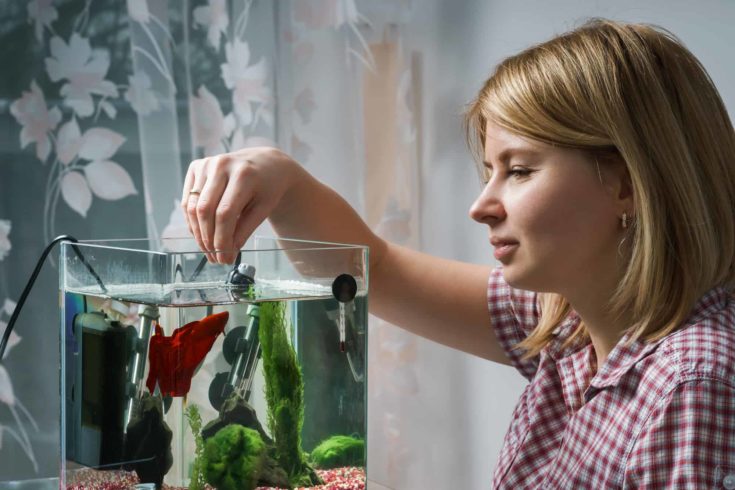
- Be careful that you don't overfeed your fish.
- Carry out weekly water changes.
- Vacuum the substrate and areas underneath plants, décor, etc., where detritus accumulates.
Every aquarium, large or small, should have a filtration system that's powerful enough to provide sufficient water flow around your tank. When choosing a filter, make sure that it circulates the total volume of aquarium water at least four times per hour.
For example, if you have a 30-gallon aquarium, you need a filter and pump that has a flow rate of around 120 GPH (gallons per hour.)
Heat Treatment
If you don't want to use chemicals in your aquarium, you might want to consider using heat to solve your Black Beard algae problem instead.
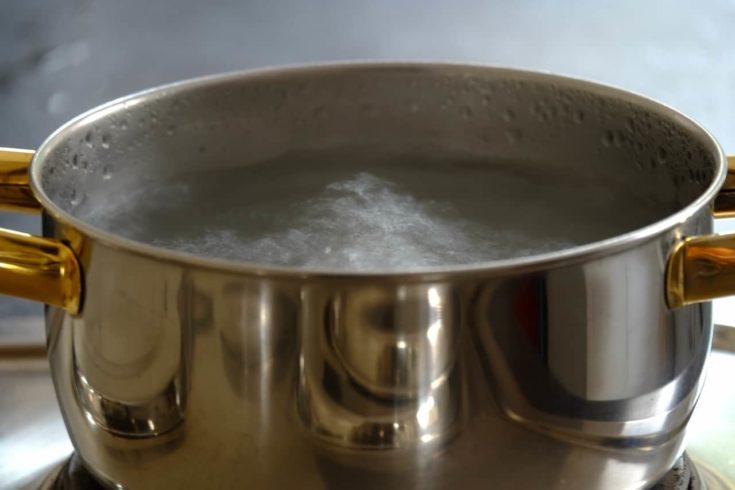
Heat treatment basically means boiling any algae-infested decorations. So, obviously, you can't use this treatment with live or plastic plants!
Place the items you want to treat in a large pot, cover everything with boiling water, and boil the whole lot for ten minutes on your stove. That should kill off any algae, including tiny spores.
Warning: Always place a tightly fitting lid on the pot, as some porous rocks and pebbles may explode when exposed to high heat.
Black Beard Algae Eaters
A few species of aquarium creatures eat Black Beard algae and can make a useful addition to your setup.
Siamese Algae Eaters (Crossocheilus siamensis) and the Florida Flag fish both eat Brush algae and can help to control it. Cherry and Amano shrimp will graze on the algae, but they won't eat it fast enough to make much of a dent in the algae's growth once it gets established.
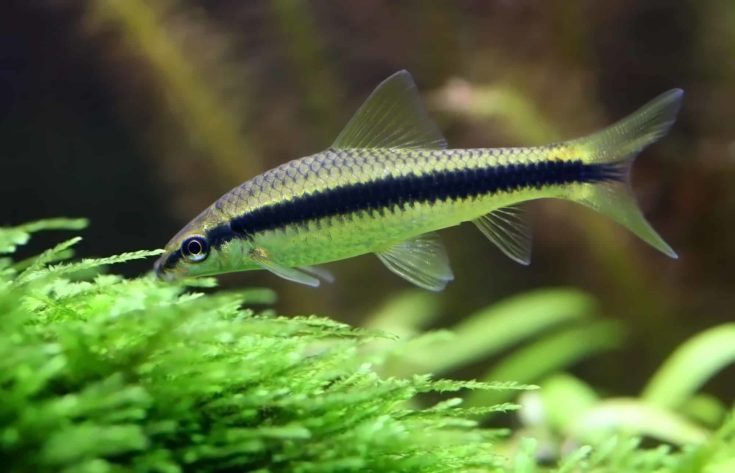
The main drawback to relying on algae eaters to control Brush algae in your aquarium is that there's no guarantee that the creatures will actually eat the algae, especially if you feed them too well!
How Do You Prevent Black Beard Algae?
Rather than having to get rid of Black Beard algae from your tank, it's far better to keep it out in the first place. There are several ways of preventing this slimy, black menace from getting into your display tank.
Quarantine New Fish
Whenever you buy new fish, you should quarantine them for two weeks and observe them for signs of disease before introducing the newcomers to your main display tank. That reduces the risk of introducing parasites, diseases, and algae spores into the aquarium.
Clean New Plants
Although you can quarantine new plants, I recommend that you clean them in a hydrogen peroxide bath instead. That will kill off parasites, bacteria, and algae, too, and you can add the plants to your tank right away instead of having to wait.
Sourcing Plants, Fish, And Tank décor
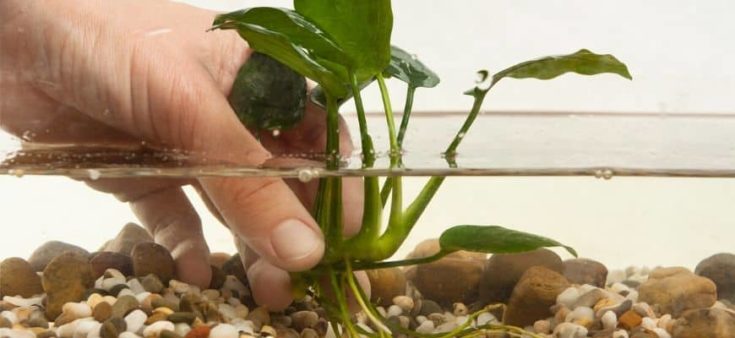
You should only buy fish and plants from reputable sources. Most good fish stores and specialist breeders quarantine their livestock before selling it on to customers and take steps to ensure that no hitchhikers are transferred to your aquarium.
Never take plants, fish, or invertebrates from the natural environment. That's not an ecologically sound practice, and you might also import problems into your aquarium.
Add More Live Plants
Live plants are excellent for your fish tank, helping to clean the water by using nitrates as fertilizer and providing shelter for your fish. An abundance of live plants also starves the algae of nutrients, helping to prevent a full-on algal infestation and keeping colonies restricted to certain parts of the tank.
Restrict Aquarium Lighting Levels
Too much light in your fish tank is sure to encourage vigorous algal growth. Restrict the amount of light to around eight hours per day, and shade your tank from direct sunlight.
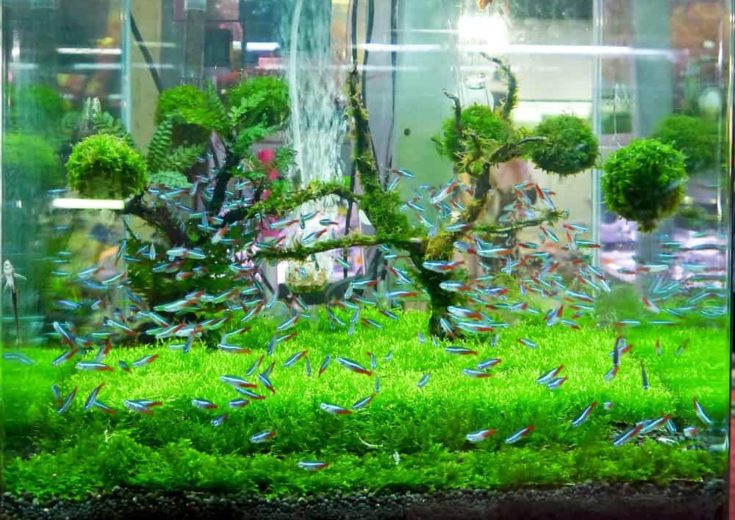
Interestingly, I had a problem with algae in one of my tanks recently, so I switched the lights off completely for three weeks. There's a small amount of natural daylight in the room where I have the tank, which proved to be adequate for my plants, but virtually all the algae died off, and my snails polished off the rest!
Maintain Your Aquarium Properly!
Clean water and a good flow around the tank will help to regulate phosphate levels and remove potential algae nutrient sources from the water.
So, make sure that you have a filtration system that produces an adequate flow rate for the size of your tank, maintain the filter media properly, and carry out 15% to 25% partial water changes every week.
Monitor CO2 Levels
Low CO2 levels can encourage the growth of Black Beard algae, so use Seachem Flourish Excel liquid carbon to boost carbon levels and prevent algae from establishing a foothold in your tank.
In Conclusion
Black Beard algae is a slimy, unsightly menace that most aquarists don't want in their aquarium. Although you can get rid of the algae by following the advice we've given you in this guide, it's better to prevent Brush algae from invading your tank in the first place.
To control algae, keep on top of weekly aquarium and filter maintenance tasks so that the tank stays clean and hygienic, quarantine new fish, clean new plants with hydrogen peroxide, and limit the hours of light in the tank.
We hope you found this guide to Black Beard algae helpful. If you did, don't forget to share the article with your friends, and tell us how you dealt with algae in your tank in the comments box below.
Getting Rid of Black Algae in Fish Tank
Source: https://www.tankarium.com/black-algae-in-aquarium/